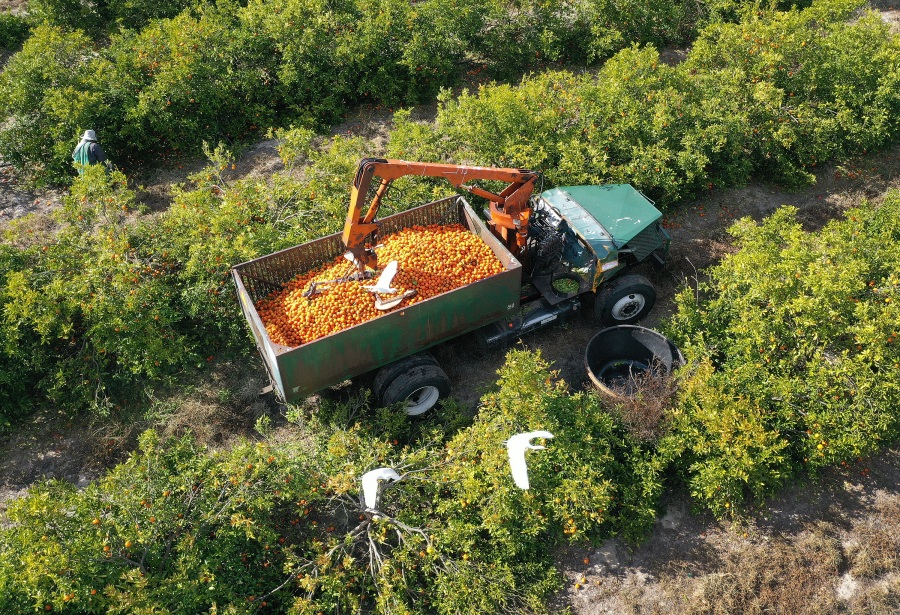TAMPA, Fla. (WFLA) — The Oct. 12 citrus forecast from the U.
S. Department of Agriculture showed production levels in Florida at their lowest since the 1940s. However, the data provided in the report reflects the situation before Hurricane Ian blew through the state, bringing floods, tree-uprooting winds, and other debris damage to the state’s orange groves.
Put bluntly, the state’s orange crop, grapefruit crop, and tangerine and tangelo crops were all down. The USDA reported only 28 million boxes of oranges were expected to come from Florida. Tampa inflation rate hits 10.
5%; still higher than nation It’s the lowest level since 1942’s orange crop season ended. Here’s how the different citrus crops in Florida measured up. Florida All Orange Production Down 32% from Last SeasonFlorida Non-Valencia Orange Production Down 40%Florida Valencia Orange Production Down 25%Florida All Grapefruit Production Down 40%Florida All Tangerine and Tangelo Production Down 7% While all of the crop decreases are significant, it’s the next three months that might show Hurricane Ian’s impacts on Florida’s citrus industry.
The next report comes out in December, which will provide a more detailed picture of how the storm hit state agriculture production. “Our agency will measure the fruit size and fruit drop to base our December 2022 Citrus forecast which will be released at noon EST on December 9, 2022,” a USDA spokesperson told WFLA. com.
“Many other agencies are assessing the losses currently but no measurable metrics are available to my knowledge. Our survey measurements for the October forecast were done prior to the arrival of Hurricane Ian. ” The Florida Department of Citrus, who manages and regulates the state citrus industry, released a statement after the forecast from the USDA, saying specifically that the damage from Hurricane Ian had hit citrus growers in the areas in its path.
Florida foreclosures increased 71% from 2021 “Hurricane Ian hit Florida citrus growers on many levels – their groves, their homes, their communities – all in the path of destruction,” Shannon Shepp, Executive Director of the Florida Department of Citrus, said. “Growers approached this season with optimism for good reason. Innovations in greening therapies and the discovery of trees that show signs of natural resistance/tolerance to the disease are teed up for deployment.
” Shepp said that Hurricane Ian had been “a setback,” but that it wasn’t the first hurricane to hit the state’s groves, and recovery assistance was on the way. “We’ll have a lot of help, we know that,” Shepp said. “On the other side of storm recovery is an industry ready to take a clear set of new tools and do what they really want to do – rebuild, recover from greening.
” Industry experts, speaking with supply chain media analysts, said the hurricane’s impact would be difficult for Florida’s growers. Matt Joyner, the CEO of Florida Citrus Mutual said the storm had flooded orange groves and “tore fruit from trees,” while speaking with Supply Chain Dive, a news outlet covering supply chain and economics. Florida orange crop to be lowest since 1945, raising juice prices “We have extensive fruit on the ground,” Joyner told Supply Chain Dive, noting that the hurricane had swept through Florida right before harvest season.
“This is gonna be a tough event for Florida growers. ” Joyner said Hurricane Ian had traveled “through a lot of the heaviest citrus producing counties in the state. ” Historically, as reported and logged by the Florida Department of Agriculture and Consumer Services, the 1941 to 1942 orange season was the lowest for decades.
Just 26. 8 million boxes of oranges were produced then. Afterward, despite hurricanes, blights, and other factors, Florida’s citrus production levels continued to rise, even with a few years of decreasing yields.
By the mid to late 1960s, Florida was averaging more than 110 million boxes of oranges every year. The crop production started to decline in the 2014 to 2015 season. Boxes produced dipped below 100 million for the first time since the 60s.
Most valuable crops grown in Florida The October USDA report on Florida citrus puts the state back at historic lows, the lowest since 1942. At 28 million boxes of oranges, orange growers in Florida already faced historically low yields. Hurricane Ian’s impacts on the groves has yet to be determined, the months ahead will involve assessment for damage, crop destruction, and recovery.
The Florida Citrus Districts, as of a new 2022 law, are: (Source: Federal Emergency Management Agency) District 1: Collier, Hendry, and Lee counties. District 2: Charlotte CountyDistrict 3: Glades, Highlands, and Okeechobee counties. District 4: Hardee, Hillsborough, Manatee, Pinellas and Sarasota counties.
District 5: Citrus, Hernando, Levy, Osceola, Pasco, Polk, and Sumter counties. District 6: Alachua, Brevard, Broward, Flagler, Indian River, Lake, Marion, Martin, Miami-Dade, Monroe, Orange, Palm Beach, Putnam, St. Johns, Seminole, St.
Lucie, and Volusia counties. According to data from the Federal Emergency Management Agency, which showed the path of the storm through Florida and highlighted counties for disaster aid, many of the citrus districts were in the hurricane’s path. The USDA’s Dec.
9 report will be the next official measure of just how much Hurricane Ian hurt the Florida citrus industry. .
From: wfla
URL: https://www.wfla.com/news/florida/florida-orange-crop-lowest-in-80-years-even-before-hurricane-ian-arrived/



